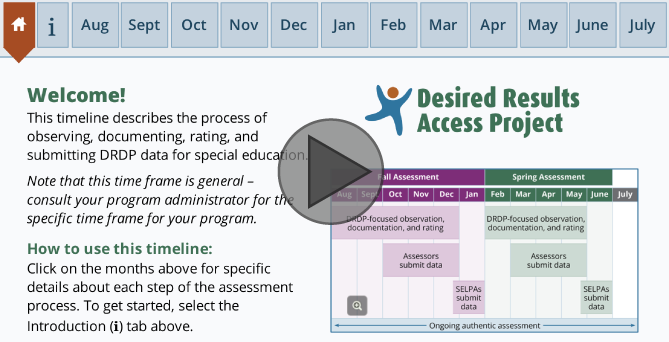
Text Transcript for the DRDP Timeline for Special Education Interactive Tutorial
Welcome
This timeline describes the process of observing, documenting, rating, and submitting DRDP data for special education.
Note that this time frame is general – consult your program administrator for the specific time frame for your program.
How to use this timeline:
Click on the months above for specific details about each step of the assessment process. To get started, select the Introduction (I) tab above.
Introduction
All eligible children must be assessed using the DRDP twice a year, in the fall and spring. The assessment should be initiated within the first 60 days of the child receiving services. To be included in the fall, children must begin services before Nov. 1; to be included in the spring, children must begin services before April 1.
Note: You must allow at least six months between the completion dates of each child’s assessment for the assessment results to be valid.
Links you might find useful:
“What is Authentic Assessment” Video
DRDP (2015) Preschool Fundamental View Manual
DRDP (2015) Infant/Toddler View Manual
Data Submission Guidance
Aug
Ongoing Authentic Assessment
The DRDP is completed based on information gathered through the use of ongoing, authentic assessment. This involves the systematic recording of observations of children over time as they are engaged in familiar activities and routines with familiar adults in familiar settings. Observations include those completed by the assessor as well as those reported by family members and other caregivers.
A more detailed description of authentic assessment can be found by clicking on this link to watch "What is Authentic Assessment" Video available on the Results Matter Video Library (toward the bottom of the page).
Sept
Ongoing Authentic Assessment
During September, assessors should continue to use effective authentic assessment strategies.
Click on the August tab to read a description of authentic assessment.
Oct
Ongoing Authentic Assessment
To be included in the fall, children must begin services before November 1.
The assessment should be initiated within the first 60 days of the child starting services.
Nov
Ongoing Authentic Assessment
To be included in the fall, children must begin services before November 1. Children entering on or after November 1 will have their first assessment in the spring.
Dec
Assessors Submit Fall Data
This time frame is general – consult your program administrator as to how and when DRDP data must be submitted.
Remember, you may still have assessments to complete for children whose services started later in the fall.
Jan
SELPAs Submit Fall Data
SELPAs have until February 1 to submit and certify their fall DRDP data. In order to meet this deadline, assessors will need to submit their data well in advance of the certification date – consult your program administrator as to how and when DRDP data must be submitted.
Feb
Ongoing Authentic Assessment
During January and February, assessors should continue to use effective authentic assessment strategies.
Click on the August tab to read a description of authentic assessment.
Mar
Ongoing Authentic Assessment
To be included in the spring, children must begin services before April 1.
The assessment should be initiated within the first 60 days of the child starting services.
Apr
Ongoing Authentic Assessment
To be included in the spring, children must begin services before April 1. Children entering on or after April 1 will have their first assessment in the fall.
May
Assessors Submit Spring Data
This time frame is general – consult your program administrator as to how and when DRDP data must be submitted.
Remember, you may still have assessments to complete for children whose services started later in the spring.
Jun
SELPAs Submit Spring Data
SELPAs have until July 1 to submit and certify their fall DRDP data. In order to meet this deadline, assessors will need to submit their data well in advance of the certification date – consult your program administrator as to how and when DRDP data must be submitted.
Jul
Ongoing Authentic Assessment
During June, July, and August assessors should continue to use effective authentic assessment strategies.
Click on the August tab to read a description of authentic assessment.
